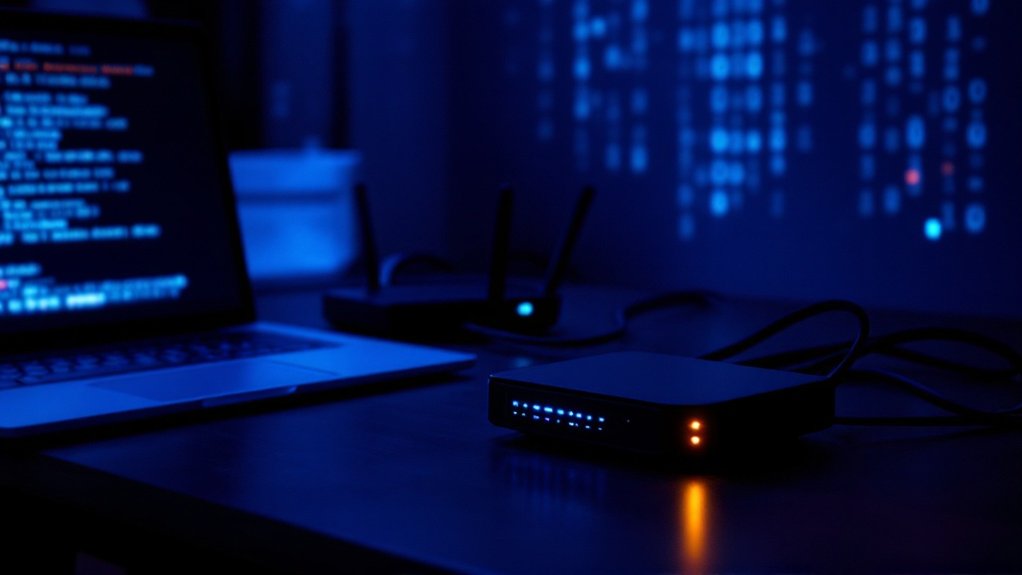IP spoofing occurs when cybercriminals forge packet headers to impersonate trusted systems across networks, enabling various forms of cyberattacks including DDoS and data theft. This technique, demonstrated in the 2018 GitHub attack that reached 1.35 Tbps, allows attackers to evade detection as they target organizations, particularly financial institutions. Organizations implement multiple defense layers, including traffic monitoring, authentication protocols, and encryption, to combat this threat. Understanding the full scope of IP spoofing reveals critical vulnerabilities in modern network security.

IP spoofing poses one of the most insidious threats to modern network security, enabling malicious actors to forge packet headers and impersonate trusted systems across the internet. Through sophisticated manipulation of network layer protocols, attackers can create IP packets with modified source addresses, effectively masquerading as legitimate devices as they exploit established trust relationships between systems. This technique has become increasingly prevalent in various forms of cyberattacks, from large-scale DDoS operations to targeted data theft campaigns. The process is similar to sending false mail where attackers deliberately conceal their true identity. Public key infrastructure provides robust authentication through asymmetric encryption to help prevent spoofing attacks.
The impact of IP spoofing attacks has been demonstrated through several high-profile incidents. In 2018, GitHub experienced a massive DDoS attack that reached 1.35 Tbps, utilizing spoofed IP addresses to amplify the attack’s magnitude. The 2011 GameOver Zeus botnet, which resulted in approximately $100 million in losses, likewise employed IP spoofing techniques to evade detection as it compromised financial institutions worldwide.
Organizations employ multiple detection methods to identify and prevent IP spoofing attempts. Network traffic monitoring systems analyze packet headers for inconsistencies, as ingress and egress filtering techniques help identify and block suspicious traffic patterns. Intrusion detection systems provide an additional layer of security by monitoring network activities for known attack signatures and abnormal behaviors. Implementing two-factor authentication has become crucial in protecting against unauthorized access through spoofed identities.
Prevention strategies against IP spoofing require a thorough approach combining technical controls and human awareness. Organizations implement strong authentication protocols, encrypt network communications, and maintain regular software update schedules to address potential vulnerabilities.
The deployment of strong firewalls and access control lists serves as a critical defense mechanism, as employee education programs guarantee staff members understand and follow cybersecurity best practices.
Although IP spoofing can serve legitimate purposes in network testing and security research, its potential for misuse has led to increased scrutiny under cybercrime legislation. Organizations must balance security measures with operational requirements while guaranteeing compliance with data protection regulations.
The evolving nature of IP spoofing attacks necessitates continuous adaptation of security measures and vigilant monitoring of network infrastructure to protect against emerging threats.
Frequently Asked Questions
Can IP Spoofing Attacks Be Traced Back to Their Original Source?
Tracing IP spoofing attacks to their original source presents significant technical challenges.
During this process, tools like packet filtering systems, network flow analysis, and intrusion detection systems can help identify spoofed traffic; however, determining the true origin remains complex.
Advanced techniques, including TTL analysis and cryptographic authentication, offer partial solutions.
But attackers using multiple spoofed addresses, especially in DDoS scenarios, can effectively mask their location through continuous IP randomization and geographically dispersed attack points.
What Software Tools Can Detect IP Spoofing Attempts in Real-Time?
Several network monitoring tools effectively detect IP spoofing in real-time.
Wireshark analyzes live packet data to identify inconsistent source addresses, whereas SNORT provides automated intrusion detection through signature-based monitoring.
SolarWinds Network Performance Monitor tracks traffic anomalies, and Nagios alerts administrators to suspicious patterns.
Advanced platforms like IP Quality Score and IPQS combine machine learning algorithms with traditional packet inspection to achieve detection rates exceeding 95% accuracy.
How Do VPNS Protect Against IP Spoofing Attacks?
VPNs establish encrypted tunnels that enclose all network traffic, making it virtually impossible for attackers to intercept or manipulate IP packets.
By masking users’ original IP addresses and replacing them with VPN server IPs, these services create a secure barrier against spoofing attempts.
Advanced VPN protocols, including WireGuard and OpenVPN, further strengthen this protection through military-grade encryption standards.
During built-in monitoring systems actively detect and block suspicious IP-based threats.
Are Certain Operating Systems More Vulnerable to IP Spoofing?
Legacy operating systems, particularly Windows 95/98/NT and early Unix systems, demonstrate markedly higher vulnerability to IP spoofing as a result of predictable TCP sequence number generation.
Modern operating systems, including Windows 10/11 and current Linux distributions, implement random number generators and improved security protocols, making them more resilient.
Mobile operating systems like iOS and Android feature built-in protections through strict security policies, regular updates, and app sandboxing, rendering them less susceptible to traditional IP spoofing attacks.
What Legal Consequences Exist for Individuals Caught Conducting IP Spoofing Attacks?
Individuals caught conducting IP spoofing attacks face severe criminal penalties, including fines up to $25 million and prison sentences reaching 10 years per count.
Civil liabilities encompass lawsuits from victims, asset freezing, and disgorgement of unlawful profits.
Regulatory bodies, including the SEC and CFTC, can impose additional sanctions, whereas international cases may trigger cross-border investigations and extradition requests, subject to varying jurisdictional frameworks.









